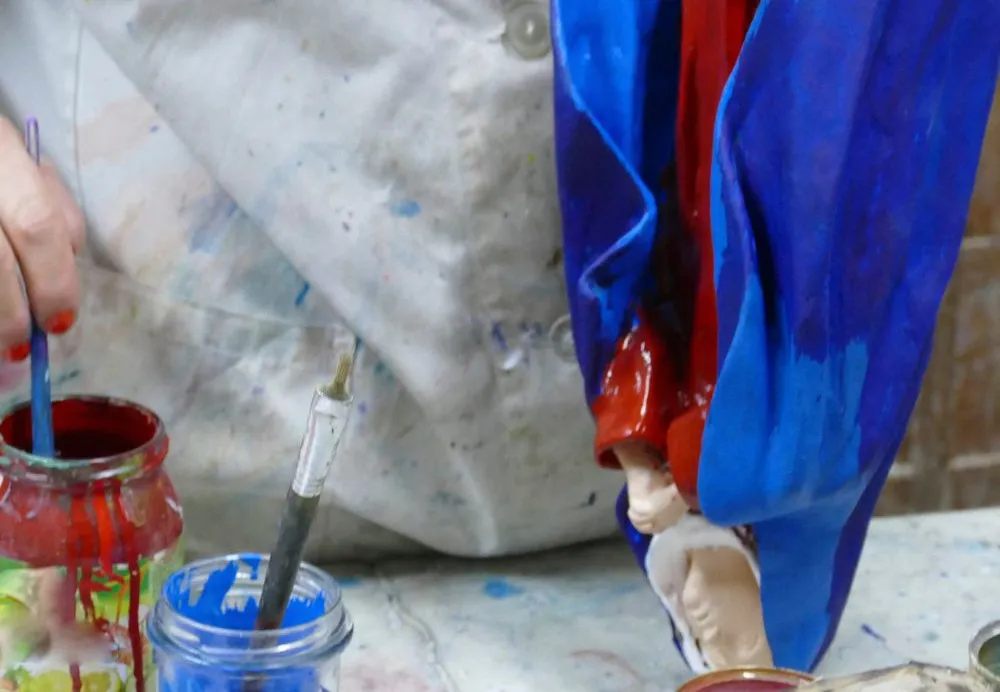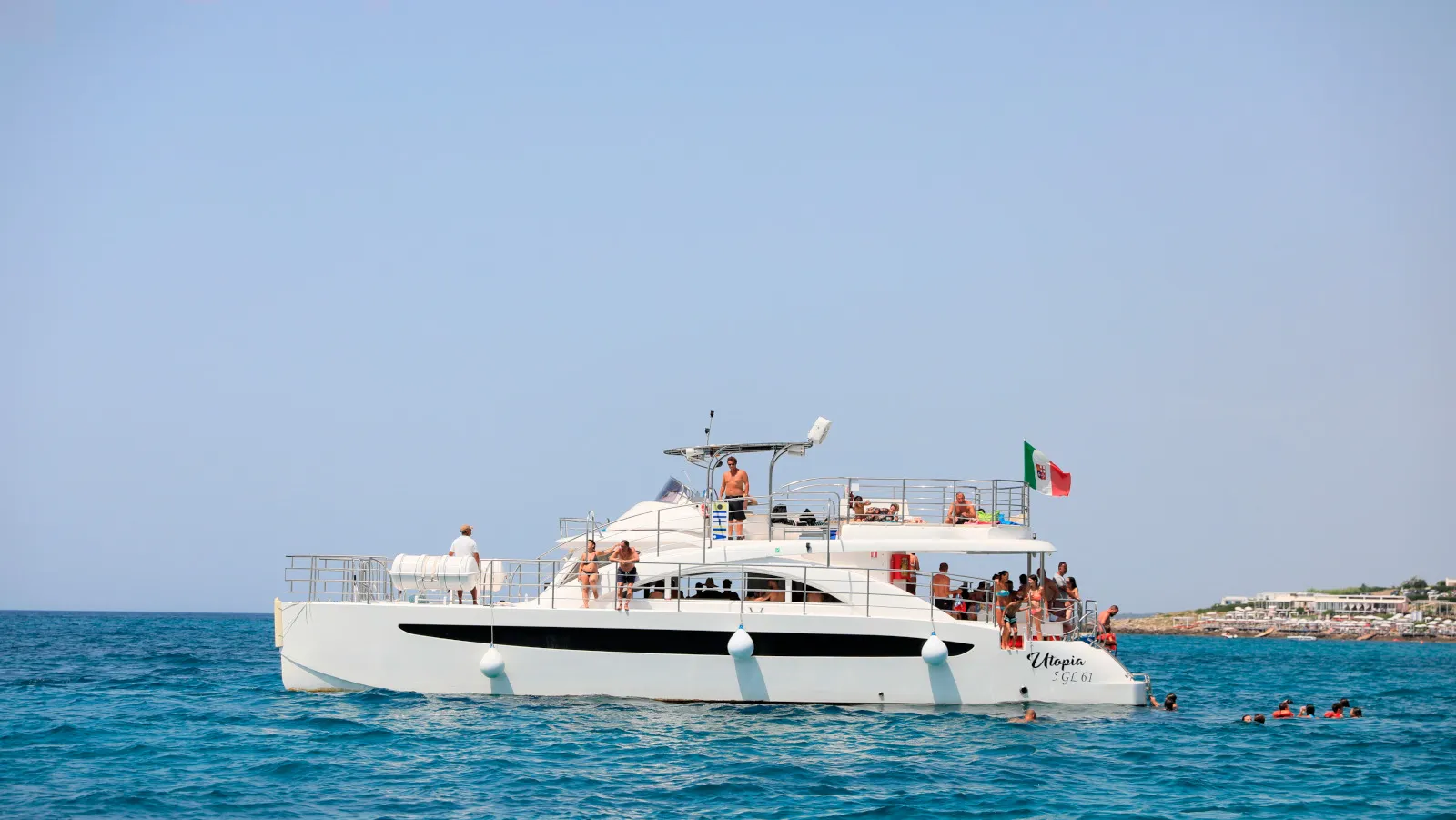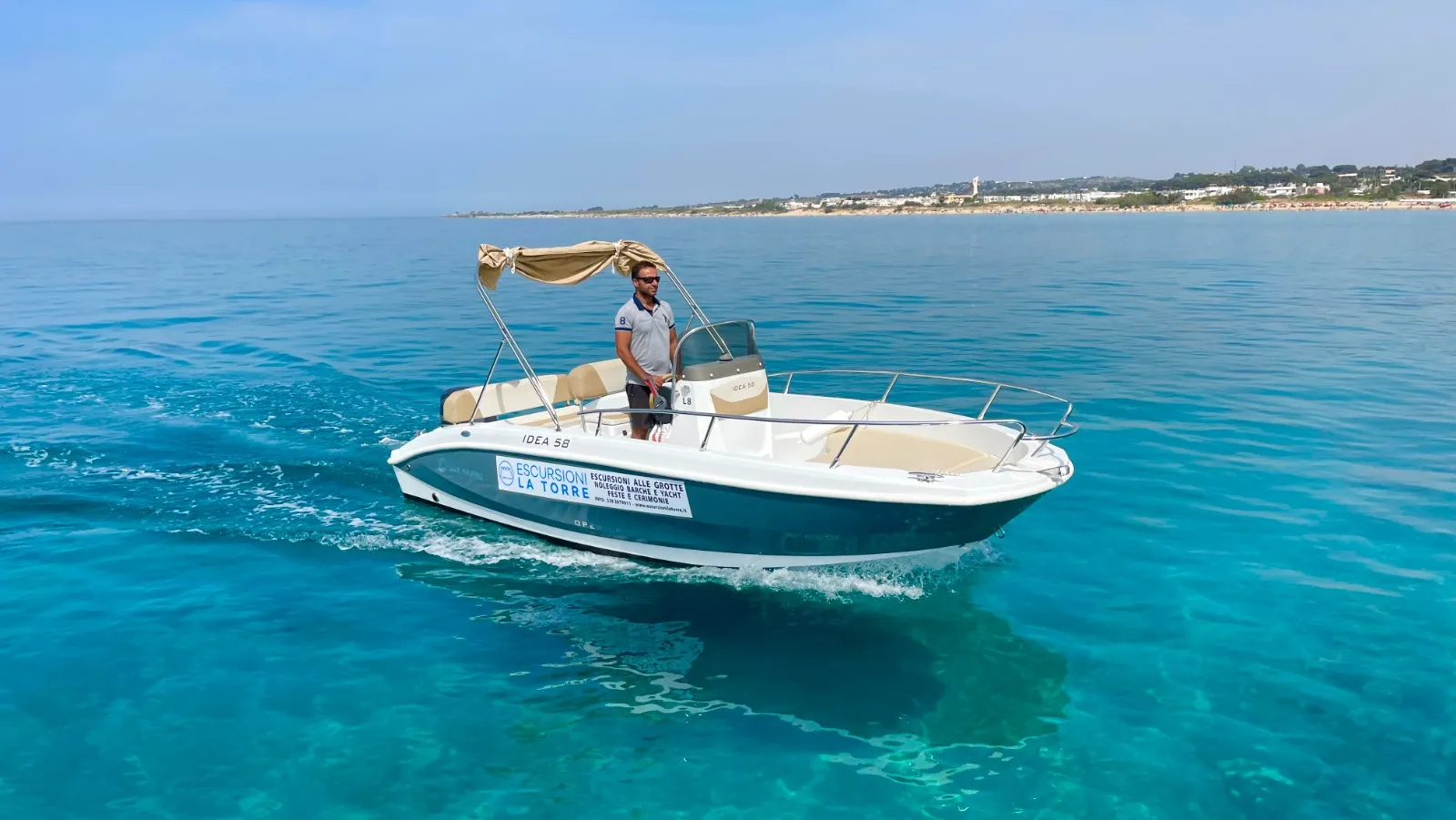Baia del Mulino d'acqua: a paradise in the waters of Otranto
Updated at: 25-01-2025
How this content can help you:
- How to reach Watermill Bay and the Collapsed Cave.
- Description of the beach: crystal-clear waters, sand, and pebbles.
- Caves to explore: Collapsed Cave, Hermit's Cave, Nun's Cave, Poetry Cave.
- How to access the caves by sea or coastal paths.
- The origin of the name "Watermill Bay."
- Activities: boat trips, snorkeling, trekking.
- Tips on parking and access to the bay.

Why is it called "Baia del Mulino d’Acqua"?
The name "Baia del Mulino d’Acqua" refers to an old water mill that was once located near the bay.
Why is it called "Grotta Sfondata"?
The Grotta Sfondata in Otranto is named after its distinctive "sunk" rock formation, resulting from a partial collapse of the ceiling that creates an opening at the top.
Baia del Mulino d’Acqua is located about 10 km south of Otranto, along the Adriatic coast of Salento. This bay is known for its crystal-clear waters and natural beauty. This charming spot features a small beach of pebbles and fine sand, nestled between rocky cliffs that create a breathtaking landscape.
How to Reach Baia del Mulino d’Acqua

By Car:
- From Otranto: Take the SP87 heading south. After about 10 km, look for signs for Baia del Mulino d’Acqua. The road can be winding and narrow, so it's advisable to drive carefully.
- From Lecce: Follow the SS16 east towards Otranto, then take the SP87 south to reach the bay.
By Public Transport:
- Train: From Lecce, you can take a train to Otranto. Once in Otranto, you'll need to take a taxi or rent a car to reach the bay, as local public transportation may not go directly to the bay.
- Bus: Some local buses may connect Otranto with surrounding areas, but you might need a taxi or another mode of transport to get closer to the bay.
By Foot or Bike:
If you're already in Otranto and enjoy walking or biking, you can explore coastal paths and secondary roads leading to the bay. Keep in mind that distances can vary and some routes may be challenging.
Where to Park?
Parking Adjacent to the Bay: There are no large official parking areas or dedicated spaces immediately near the bay. However, at certain times of the year, you may find informal parking spots along the road or adjacent to the bay. These spots are often limited and can fill up quickly.
Parking in Otranto: If you can't find direct parking near the bay, you can park in Otranto and then proceed by taxi, rental car, or bike. Otranto offers several parking options, both free and paid. There are parking areas near the city center and the train station that can serve as a starting point for the rest of the journey to the bay.
Parking in Nearby Areas: Some secondary roads or residential areas around the bay may offer parking spaces. You’ll then need to walk a bit to reach the bay, so make sure to wear comfortable shoes and be prepared to walk the necessary distance.
The Beach of Baia del Mulino d’Acqua

The beach of Baia del Mulino d’Acqua is a charming and relatively hidden spot along the Adriatic coast of Salento. This small beach has a unique charm that sets it apart from more crowded destinations.
Imagine arriving and finding a small beach characterized by a combination of fine sand and pebbles. This mix gives it a natural and authentic appearance, perfectly complementing the surrounding landscape.
The pebbles, while making access to the water less comfortable compared to sandier beaches, add a rustic and genuine touch to the place.
The waters of the bay are simply stunning: crystal-clear and intensely blue, offering exceptional visibility. This makes them perfect for swimming and snorkeling, allowing you to discover the seabed and observe the marine life inhabiting these clear waters.

The beach is framed by rocky cliffs and lush Mediterranean vegetation.
The cliffs, which embrace the bay, not only create a dramatic and picturesque landscape but also help protect the beach from winds, making the environment particularly calm and welcoming.
To reach the beach, you'll need to walk a short distance from parking areas or nearby roads. The paths can be natural and sometimes rugged, so it's advisable to wear comfortable shoes for the journey.
It’s good to know that the beach does not have tourist facilities such as restaurants or shops. This means you'll need to be self-sufficient, bringing everything you need for the day, such as food and drinks.
€ 130
Why is it Called Baia del Mulino d’Acqua?
The name "Baia del Mulino d’Acqua" refers to an old water mill that was once located near the bay.
This type of mill used the power of flowing water to grind cereals and produce flour, a common practice in the past.
Remnants of structures related to water mills can sometimes be seen near waterways and coastal areas in Italy.
The part "d’Acqua" in the name indicates that the mill used water as an energy source, typical of water mills.
This connection with water not only describes the function of the mill but also reflects the historical and functional importance of water resources for the area's economic activities.
Main Caves of Baia del Mulino d’Acqua
Grotta del Muro di Vento:
Description: This cave, located near the bay, is characterized by a narrow entrance that opens into a larger cavity inside. The name comes from the wind currents that can be felt inside the cave, especially during certain times of the year.
Access: It is accessible by sea and can be explored during a boat trip or by kayak.
Grotta della Foca:
Description: In the Baia del Mulino d’Acqua area, there is also a cave called "Grotta della Foca," named because it used to host sea lions. Today, the cave is of interest to those who enjoy exploring marine caves and observing marine life.
Access: It is also primarily accessible by sea.
Grotta della Madonnina:
Description: This cave is known for a small statue of the Madonna found inside, a tribute to local religious tradition and culture. The cave offers a suggestive environment and is of great historical and cultural interest.
Access: It can be visited by boat or through guided tours that allow you to approach the entrance of the cave.
Grotta del Tetto:
Description: The Grotta del Tetto is characterized by a natural opening that forms a roof above the entrance of the cave, creating a scenic effect. This cave is interesting for its geological formation and the marine ecosystem it hosts.
Access: It can be explored by sea, with snorkeling or diving activities.
What to do at Baia del Mulino d’Acqua?
There are organized tours and excursions that can take you to discover Baia del Mulino d’Acqua and its surrounding beauties.
Boat Excursions and Snorkeling
Various companies offer boat excursions that include visits to marine caves, snorkeling, and coastal explorations. These tours can be a great opportunity to visit Baia del Mulino d’Acqua and nearby caves such as Grotta Sfondata, Grotta dell’Eremita, and Grotta della Monaca.
Guided Coastal Tours
Some tours include guided walks along the coast, which may include a visit to Baia del Mulino d’Acqua and its natural wonders. These tours often provide explanations about the history and geology of the area.
Equipment Rental and Water Activities
If you prefer to explore on your own, you can rent water sports equipment like kayaks and paddleboards. These rentals will allow you to explore Baia del Mulino d’Acqua and its caves independently.
Hiking and Nature Excursions
If you're interested in exploring on foot, some agencies offer excursions and hikes along coastal trails that can take you close to Baia del Mulino d’Acqua and other natural beauties of the area.
Which Caves to Explore Near Baia del Mulino d’Acqua?
Near Baia del Mulino d’Acqua, there are several interesting marine caves you can explore. Here are some of the most notable caves in the area:
- Grotta Sfondata
- Grotta dell’Eremita
- Grotta della Monaca
- Grotta della Poesia
Grotta Sfondata

Grotta Sfondata is one of the most spectacular and fascinating marine caves along the Adriatic coast near Otranto. Located in an area characterized by high cliffs and crystal-clear waters, the cave is famous for its unique geological formation.
The cave takes its name from the "sfondata" appearance of its opening. The term "sfondata" refers to the visual effect created by the erosion and collapse of part of the cave's vault, leaving a large hole or opening.
This phenomenon creates a unique atmosphere inside the cave, with sunlight filtering through the opening and illuminating the rocky walls.
The interior of the cave is characterized by limestone walls shaped by the sea and currents. The rock formations and play of light create spectacular reflections and colors. The clear, blue waters of the cave contribute to a charming and evocative environment.
There is no sandy beach directly adjacent to Grotta Sfondata, but the nearest is Spiaggia di Cala dei Normanni. It is a small sandy and pebbly beach and can offer a nice opportunity to relax after visiting the cave.
How to Reach Grotta Sfondata in Otranto?

The most common and convenient way to visit Grotta Sfondata is to join a boat excursion. Several companies in Otranto offer tours that include a stop at the cave and often at other coastal wonders in the area.
If you like the idea of a more active adventure, you can rent a kayak or paddleboard. This gives you the freedom to explore the area at your own pace and get close to the cave.
Although direct land access to Grotta Sfondata is not very practical, you can approach the cave from some nearby beaches, such as Spiaggia di Santo Stefano. From there, there are coastal trails that allow you to explore the area and get closer to the cave.
Keep in mind that the paths may be slippery and challenging, so it is important to wear appropriate footwear and be prepared to walk on uneven terrain.
Grotta dell’Eremita
Grotta dell’Eremita is characterized by its wide opening and the internal rock formations shaped by marine erosion. The cave’s walls are sculpted by the sea and sand, creating a picturesque and evocative environment.
The water inside is crystal clear, and the play of light that filters through the natural opening creates a charming atmosphere.
The name "Grotta dell’Eremita" reflects a historical or legendary connection with religious or solitary figures who might have sought refuge in this natural cavity.
Although there are no concrete historical records, the name evokes the image of a place of meditation and solitude.
Grotta della Monaca
Grotta della Monaca is a fascinating natural site known for its beauty and local legends, adding a touch of mystery to its exploration.
The name "Grotta della Monaca" is reflected in local legends and stories.
The term "Monaca" may refer to a religious figure or a legend of a nun who, according to popular traditions, sought refuge or meditated in this place. Although there are no concrete historical records, the name evokes the image of a sacred or reflective place.
Grotta della Poesia
Although not immediately near Baia del Mulino d’Acqua, Grotta della Poesia is one of the most famous caves in Salento, located in Roca Vecchia.
The name "Grotta della Poesia" comes from the poetic beauty of the place and its enchanting atmosphere. It is one of the most romantic and evocative spots on the Salento coast, often associated with poetry and natural beauty.
Grotta della Poesia is a large natural cavity situated within a natural pool formed in the limestone rock. The cave is partially open, with a large opening at the top that allows sunlight to illuminate the water below, creating an enchanting atmosphere.
The water inside Grotta della Poesia is an intense and crystal-clear blue, ideal for swimming and diving. The natural pool is surrounded by rocky walls and Mediterranean vegetation, offering a picturesque and captivating environment.
Conclusions
Both Grotta Sfondata and Baia del Mulino d’Acqua offer exceptional and varied experiences of the coastal beauty of Otranto.
Grotta Sfondata is a must for adventure and marine nature lovers, while Baia del Mulino d’Acqua is perfect for a relaxing day and immersion in tranquility.
Both locations represent the best of the Salento coast and promise memorable visits for anyone wishing to explore the beauty and culture of this charming region. With a little planning and the right precautions, you can fully enjoy the wonders that these two corners of Otranto have to offer.
If you want to spend an unforgettable vacation, we recommend one of the Masserie in Otranto, near Grotta Sfondata.




